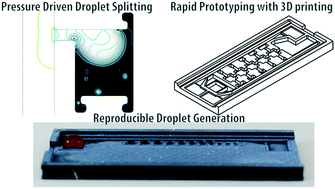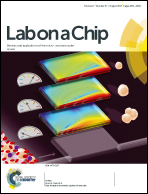Magnetically manipulated droplet splitting on a 3D-printed device to carry out a complexometric assay†
Abstract
A method for performing droplet actuation, splitting, and dispensing using only magnetic force and physical confinement is reported. The combination of low-friction superhydrophobic surfaces and droplets containing superparamagnetic particles is demonstrated to reliably dispense droplets with a precision (≤6%) similar to standard air-displacement pipettes. The 3D printed microfluidic chips incorporate individual wells, a weir structure and differential channel depths to facilitate droplet splitting in differing ratios. Both empirical observations and numerical simulations show that the splitting is a combination of wetting and pressure differences. The method enables a parent drop to be dispensed and split into droplets ranging in size from 5–20 μL using different well volumes. Once dispensed/split the droplets can be further actuated, merged and mixed. An EDTA-based complexometric colorimetric titration for water hardness is conducted on-chip. The degree of colour change is then determined utilizing a cell phone camera and image analysis and used to calculate water hardness; this measurement was found to agree with the traditional, larger scale method. The simple, robust dispensing method is adaptable to other digital microfluidic assays.



 Please wait while we load your content...
Please wait while we load your content...